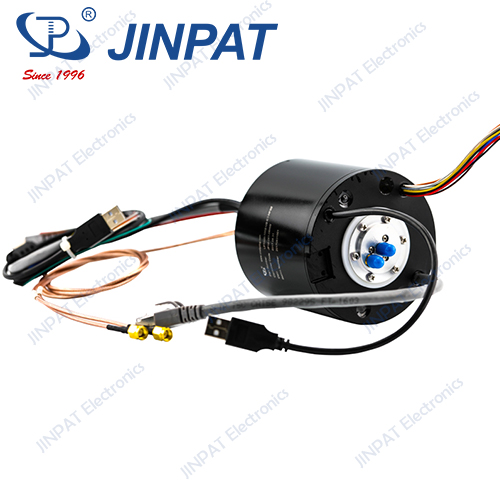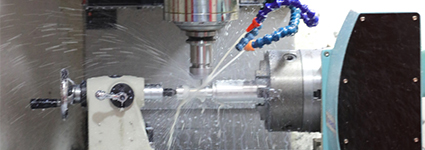


Mechanical laser radar is a widely used sensor technology for distance measurement, 3D modelling and environmental sensing. Their operation involves emitting and receiving laser beams, often requiring rotating components to scan the environment. To ensure continuous rotation and transmission of power and data signals, mechanical laser radar typically uses electrical slip rings or optical fibre […]

Mechanical laser radar is a widely used sensor technology for distance measurement, 3D modelling and environmental sensing. Their operation involves emitting and receiving laser beams, often requiring rotating components to scan the environment. To ensure continuous rotation and transmission of power and data signals, mechanical laser radar typically uses electrical slip rings or optical fibre slip rings to support the transmission of power signals.
One of the remarkable features of many laser radars on the market is that their operating wavelengths coincide with the ranges of optical signals that optical fibre slip rings can transmit. This makes solving the signal transmission problem for a mechanical laser radar relatively simple. For example, most optical fibre slip rings developed by JINPAT support operating wavelengths between 650 and 1650 nanometres, with only a few models operating between 850 and 1550 nanometres. These ranges cover almost all major laser radar operating wavelength ranges. In addition, the optical fibre slip rings developed by JINPAT have excellent electrical characteristics and must be capable of transmitting high-current and high-frequency signals to meet the power supply and data transmission requirements of laser radar.

For mechanical laser radar, the amount of data generated is relatively small and there is no need to transmit data over long distances. Since mechanical laser radar typically requires continuous operation for long periods of time, the slip rings must have high strength and stability to minimise maintenance needs. Thus, the use of single-channel multimode optical fibre contact rings can effectively solve the laser radar signal transmission problem. This approach has two undeniable advantages: one is better matching with the operating wavelength range of laser radar, and the other is that optical fibre slip rings have an extremely long service life, capable of withstanding hundreds of millions of revolutions, fully satisfying the long-term maintenance requirements of laser radar.
Once the signal transmission problem is solved with optical fibre slip rings, the power transmission problem will be simplified. The mechanical design of the slip rings should match the mechanical design of the laser radar to ensure stability during mounting and wiring. A reasonable mechanical design helps to reduce friction and wear, extending the life of the slip rings. The use of conventional electro-optical integrated slip rings may lead to insufficient service life and increase the volume of the laser radar, affecting its stability. As for rotating conductive solutions, as a specialised slip ring manufacturer, JINPAT offers solutions for wireless coil powering.
In conclusion, the selection of suitable slip rings for a mechanical laser radar depends on the specific requirements of the radar. Different models and manufacturers of laser radars may require different types of slip rings to ensure their performance and reliability. Consequently, the selection of slip rings should be based on a comprehensive consideration of these factors. Feel free to contact INPUT and we will provide high quality solutions.

JINPAT photovoltaic slip rings have high quality and competitive price. JINPAT has provided hundreds of models of electro-optical rotary joints for both civil and military industries. Most of JINPAT electro-optical slip rings have high transmission capacity. High-end slip rings can transmit 4K@60FPS high-definition video signals. OVERVIEW Design product sketches and models using SOLIDWORKS 3D Computer […]

With many years of experience in managing various types of projects, the management team of JINPAT is able to eliminate all obstacles that arise during the execution of projects to ensure that the technology is followed and the products are manufactured successfully. In addition, JINPAT understands the importance of good documentation. Documents such as certificates […]

JINPAT carries out precision machining of all components of its products. At all stages of production, from drawing to molding, JINPAT is committed to being precise and ensuring that the best slip rings are produced. With the ability to machine parts to a tolerance of 5 microns, our experienced, highly skilled team uses the latest […]

JINPAT welding technicians are experts in Gas Metal Arc Welding (GMAW), Flux Cored Arc Welding (FCAW), Gas Tungsten Arc Welding (GTAW) and Semi Metal Arc Welding (SMAW). They are dedicated individuals who value precision and aesthetics in the production of machine components. OVERVIEW Welding procedures comply with codes such as ASMEIX, AWS, DIN, API, B31.1, […]

JINPATElectronics is a customer-oriented corporation. We do our utmost to provide our customers with high-standard solutions for transmission including rotation. Up to now, JINPAT has provided its services to more than 10,000 customers worldwide. Each slip ring produced by JINPAT undergoes a series of rigorous and systematic inspections and durability tests before being delivered to […]

With advanced testing and measuring devices, JINPAT’s Quality Control Department conducts systematic inspections of our products. Our quality measurement system complies with ISO 9001:2015. JINPAT has great confidence in its products and has earned a good reputation for producing products of unrivaled quality. REVIEW Detailed inspection and provision of data in the form of documentation […]